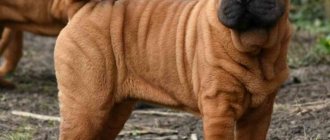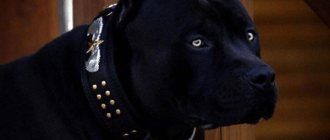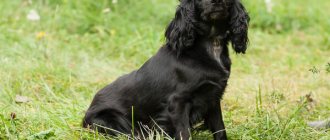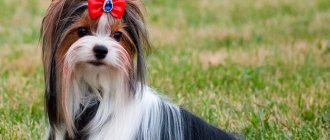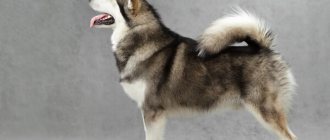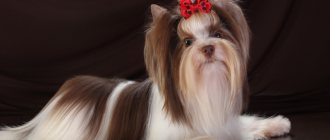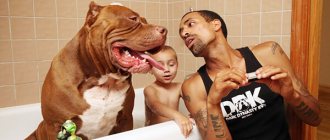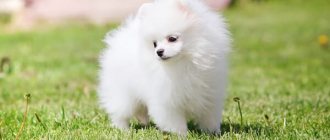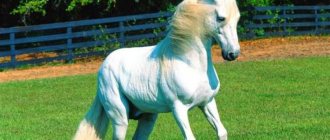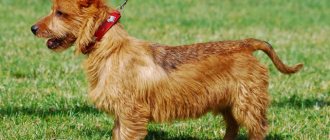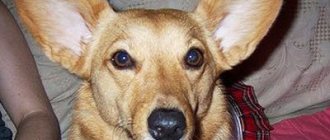The Pinscher is a breed originally bred as a guard and fighting dog. Over time, smaller versions of pinschers were developed and used as rat-catching dogs for hunting and eliminating vermin in homes and farms. According to the Fédération Cynologique Internationale, there are six officially recognized breeds of Pinscher: Doberman Pinscher, German Pinscher, Affenpinscher, Austrian Pinscher, Miniature Pinscher and Danish-Swedish farm dog. In addition, there are unrecognized breeds of pinscher, for example, the Carlin Pinscher and the Harlequin Pinscher.
Origin of the name of the breed
Documented as a singular noun in 1926, "pinscher" is of Germanic origin and is a type of fox terrier dog. Although German etymologists believe that this word was borrowed from the English dictionary. The breed's name is probably a reference to the ear cropping of most Pinschers. Ear cropping has been done since ancient times, mainly on farm dogs and guard dogs, as it was believed that large ears made easy targets for fighting dogs. Ear cropping is now banned in many countries as an unnecessary and cruel practice.
The English word "pinch" comes from an Old French word meaning "to pinch, squeeze, bite or steal." While the most commonly accepted definition of a pinscher relates to the cropping of a dog's ears, an alternative definition may refer to describing the pinscher's work as a rat catcher, guard dog, and fighting dog, and may broadly mean "biter".
To watch online, click on the video ⤵
Survival [Part 9] Caught a wild boar in a trap. Fried liver and ribs in a cauldron. More details
Survival [Part 8] Wild boar trap. What I caught. More details
Vitalik Ignatyuk – RYTP 4 Read more
24 HOURS IN THE BATH! | RYTP, VITALIK IGNATYUK, Vitalik Ignatyuk Read more
24 HOURS IN A FRYING PAN RYTP (Vitaly IGNATYUK) PUP PULP Read more
LIFE IN THE FOREST WITH PIKES [RYTP] Vitalik Ingnatyuk/Vitalik Ignatyuk Read more
Vitalik Ignatyuk – RYTP Read more
Vitalik Ignatyuk RYTP. Part 3. (Pisun fishing) Vitalik Ignatyuk rvtp. #rytp #rvtp Read more
Boar net trap [Part-4] More details
Caught a Wild Boar in a Trap [Part 6] More details
Survival [part 5] Boar trap Unknown creature in the forest at night More details
Vitalik Ignatyuk hunting for Sausages RYTP Read more
Life in the forest! [Part 2] Caught a wild hare! Stewed hare with vegetables in a cauldron. More details
VITALIK IGNATYUK ON NTV Read more
VITALIK IGNATYUK IS MISSING BOBA! More details
Vitalik Ignatyuk RYTP. Part 2. (Three on a picnic) Vitalik Ignatyuk rvtp. #rytp #rvtp Read more
RYTP#1 Vitalik Ignatyuk is looking for a Christmas tree More details
CRASH HUNTING FOR BEANS [RYTP] Vitalik Ingnatyuk/Vitalik Ignatyuk More details
VITALIK IGNATYUK ON YAKUTIA 24 | YAKUTAN VITALIK IGNATYUK Read more
Source
Origin of Pinschers
The oldest recorded Pinscher is the German Pinscher, which first appeared on farms in the early 15th century . Bred as fighting dogs and rat catchers, German Pinschers have a naturally strong hunting instinct, and early illustrations show compact, medium-sized dogs with a narrow muzzle and short-cropped ears. In 1890, Ludwig Dobermann bred the Doberman Pinscher as a tough guard dog. The Doberman's ancestry is believed to include the German Pinscher, Rottweiler and Weimaraner.
Photo gallery
Finally, you can take another look at all the breeds that make up the Pinscher group. Starting from the largest - the Doberman pinscher and ending with the smallest - the miniature pinscher.
Austrian Pinscher
- Height: from 42 to 50 cm
- Weight: from 12 to 18 kg
- Life expectancy: 12 to 14 years
- Temperament: Confident, lively, playful, friendly, loyal, alert
The Austrian Pinscher has a medium-sized body with a strong neck and chest, a long curled tail, a long muzzle with almond-shaped eyes and a black nose. They will make good family companions and watchdogs.
The Austrian Pinscher was bred at the end of the 19th century. At that time, rural farmers needed a dog that would act as a watchdog and also protect their farms from wild rats. Breeder Emil Hauck crossed German Pinschers with local dogs, and the result was a success. In 1928, the breed was recognized by the Austrian Kennel Club as the Austrian Shorthaired Pinscher.
Austrian Pinschers are playful by nature, love their owners, and are also good with children. They are especially happy living in rural or suburban areas. trains very .
Possessing a protective instinct, Austrian Pinschers selflessly guard the property of their owners and immediately bark when confronted with suspicious individuals or unexpected noise.
IMPORTANT! They need a lot of training and activities. Take your dog on regular runs and walks and let them play every evening in an area with secure fencing.
Austrian Pinschers do not have any particular behavioral problems. However, some dogs can become overly possessive of their family members. If you feel your puppy is developing this temperament, start by socializing him.
Nutrition
The issue of feeding the pinscher is extremely important. If an animal receives few microelements and nutrients, it becomes weak. To prevent your pet from getting fat and not facing the problem of impaired metabolism, we advise you to organize fractional balanced meals for him.
40% of your miniature pinscher puppy's should consist of animal products, especially milk and raw meat. Additional products he needs for growth and development are cereals, fruits, berries and vegetables. Sample menu:
| Meal number | Food/drinks |
| 1 | Raw meat (rabbit, turkey, chicken), water |
| 2 | Vegetable soup, water |
| 3 | Milk, raw meat |
| 4 | Fruits, vegetables or porridge, water |
The dog is switched to dry food when it turns 1 year old. It is recommended to feed him twice a day, 150-200 grams. Never give him sweets or smoked foods.
Doberman
- Height: from 61 to 72 cm
- Weight: from 32 to 45 kg
- Life expectancy: 12 to 13 years
- Temperament: intelligent, energetic, fearless, loyal, alert, obedient, confident
The Doberman Pinscher is a dog full of contradictions. Although he has long had a reputation as a daring and even sinister dog, loyal fans of the breed consider the Doberman to be the most loving and faithful companion. And no, “loyal” is not a euphemism for “loves only his master.” Believe it or not, the Doberman will be a balanced and friendly pet unless you threaten his family.
Did you know that the Doberman is a German breed of dog that was created by tax collector Louis Doberman to protect himself and the money he collected from thieves. To create an intelligent and loyal guard dog, he crossed short-haired German Shepherds with Rottweilers, Black and Tan Terriers and German Pinschers. Smooth-haired dogs such as greyhounds and Weimaraners may also have been part of his "recipe".
Created as a watchdog, the Doberman has an innate ability to not only protect its family, but also to anticipate dangers and threats . But if a Doberman is not socialized and trained to behave properly around strangers, he may become overly suspicious of guests in your home—a wariness that can develop into aggression.
Although most people are only familiar with the black Doberman with rusty markings, the breed actually comes in a variety of colors: blue (actually grey) with rusty markings; various shades of tan with rusty markings; and a light brown paint job called Isabelline, which also has rust marks.
WARNING! Keep in mind that white or cream Dobermans are a genetic mutation associated with serious health problems; they are not valuable and expensive rarities.
The Doberman's intelligence, trainability, and courage make it capable of fulfilling many different roles, from working police or military dog to family protector and companion. The Doberman is energetic, empathetic, decisive, alert and flexible. Only with close contact with his family, proper socialization and training will he not show aggression and other destructive behavior. A Doberman that is kept alone in the backyard will never become a loving protector but will instead become a fearful dog that is aggressive towards everyone, including its family members.
Character
Most people believe that if a dog is small, it means it is of a decorative nature. It is not always so. The character of the miniature pinscher is significantly different from the character of, for example, the Maltese. Such a dog is brave, courageous and very self-confident.
The main advantages of the breed include:
- Good aptitude for learning.
- Love for household members.
- Sincere affection for the owner.
- The desire to protect loved ones.
- Obedience, lack of hysteria.
The Pinscher is a good-natured and affectionate pet who will reciprocate every person who shows sympathy for him. However, you should not expect that he will get along with an unfamiliar person who does not express good nature at all. The animal loves to communicate with bright, cheerful people, because it understands that the same energy comes from them as from itself.
This is a very loyal animal that is incapable of betrayal. He chooses the owner carefully, looking closely at each member of the household. Usually, the main thing in the life of such a dog is the person who treats it attentively (trains, cares for and feeds it).
Due to the presence of security potential, he often openly expresses distrust of strangers. It can bark and even bite if it feels threatened. But as soon as the dog sees the owner shaking the stranger’s hand, his suspicion will immediately disappear.
The baby pinscher is not without its shortcomings. Firstly, he is quite capricious. If the owner asks to do something uninteresting, for example, to come up while the animal is playing, he may even snap back. But this happens extremely rarely; most of the day the dog is cheerful and playful.
Secondly, she is distinguished by pride. Will never put up with rude treatment. He can be offended for a long time by abuse directed at himself. The Pinscher is a vindictive dog who will not forgive everyone for being rude or ignored.
The main difference between a representative of the breed is leadership. He tends to dominate. If other animals live in the house, he immediately establishes relationships with them according to the model “you are a subordinate, I am the boss.” No one doubts the superiority of the miniature pinscher. It's hard to believe, but he has good makings of a fighting dog.
There is little that can intimidate him. Courage and courage are qualities bestowed upon him by nature. However, the dog is quite balanced and well controlled. Able to quickly respond to current events. Has a sharp mind.
German pinscher
- Height: from 43 to 51 cm
- Weight: from 11 to 20 kg
- Life expectancy: 12 to 14 years
- Temperament: smart, loving, lively, balanced, energetic
The German Pinscher is not a smaller version of the Doberman Pinscher, the breed has a much longer history. It was used as an all-purpose farm dog and rat catcher, but the breed almost disappeared after World War II and was only brought back with the help of its descendant, the Miniature Pinscher. Today the German Pinscher is primarily a family companion and show dog.
If you are looking for a medium-sized dog that is bold, territorial and alert, you may want to consider the German Pinscher. This is a reliable friend and adventure partner with almost limitless energy . However, he will be a good choice for you only if you have leadership qualities. The German Pinscher is very assertive, decisive and manipulative; he will run your home if you let him.
Did you know that this German dog breed is considered the oldest of all Pinscher breeds, having given rise to dogs such as the Doberman Pinscher, Miniature Pinscher, Affenpinscher, Miniature Schnauzer, Giant Schnauzer and Standard Schnauzer. They were first mentioned in books dating back to 1884, where they were called smooth-haired pinschers.
With their smooth, shiny coat and neat, muscular body, German Pinschers look regal and confident. This breed's short, dense coat comes in a variety of colors, including black, brown, fawn and tan. Blue German Pinschers are rare , but some dogs have black fur with a blue tint.
Although every dog is different, in general the German Pinscher has a bold and curious personality. German Pinschers require a lot of exercise. They enjoy walking, hiking, jogging with their owners, and chasing balls and frisbees.
This breed is incredibly affectionate with members of the human family and is relatively open to meeting new people. German Pinschers are also quite tolerant of children and other dogs. They enjoy being an active part of the family and participating in daily activities and activities.
A little history
Translated from German, pinscher means “biter.”
In fact, dogs of this breed have a tough temperament and, without much difficulty, will be able to provide all possible resistance to an enemy who poses a real threat.
Their homeland is Germany. The breed was officially approved in 1879.
After which dogs became widespread throughout Europe. 16 years later, the Pinscher Club was founded by German dog handlers.
Initially, dogs were both smooth-haired and wire-haired. Moreover, such different offspring were observed in one litter.
It was the smooth puppies that were called pinschers, but the puppies with hard fur were called schnauzers.
In order to breed individuals that meet all the requirements of the breed, it was decided to obtain smooth puppies through at least three generations.
Currently, the following types of dog breeds are distinguished (depending on size): standard pinscher and mini.
Miniature Pinscher
- Height: from 25 to 30 cm
- Weight: from 3.5 to 5 kg
- Life expectancy: about 15 years
- Temperament: smart, playful, confident, responsive, friendly, energetic, independent, active
This is one of the most active dog breeds. Miniature pinschers are always on the move. This is good if you like activity and fun; this is bad if you like peace and quiet. Most miniature pinschers burn off most of their energy playing indoors and do not require much space to exercise.
Slender and graceful yet strong, the Miniature Pinscher is, in fact, one of the tallest miniature dogs . However, the weight is relatively small - from 4 to 5 kilograms. The coat is short and smooth.
Fun fact: the Miniature Pinscher is not a Miniature Doberman Pinscher. Although they both come from Germany, that's where their connection ends. The Miniature Pinscher is a unique breed, likely the result of crossing a German Pinscher, a Small Shorthair Terrier, a Dachshund and an Italian Greyhound.
The miniature pinscher is a perpetual motion machine. These cheeky, curious and agile dogs are always ready to play. They have been dubbed the “King of Toys” not only because of their majestic appearance and size, but also because they love toys. A person who shares his life with a miniature pinscher is never bored.
WARNING! True to their terrier heritage, these dogs can be harsh with other dogs and enjoy the opportunity to play hunter. Miniature Pinschers can be so engrossed in what they are doing that they will ignore your commands. Some would even call them stubborn. This is not a breed that can be safely let off a leash.
Differences from that terrier
These are completely different breeds of dogs of relatively small size.
At the moment, both of them are considered lap dogs and even decorative dogs.
Although none of the breeds were bred as domestic toys, each had a special role. The terrier and the pinscher are similar in color, but in everything else there are only differences.
The Pinscher is a larger, more athletic and powerful dog. The chest is more developed than that of terriers, but their limbs are shorter.
Pinschers tend to be aggressive towards strangers. Although they are polite and patient with children.
This is an unsurpassed guard and devoted friend, just like the toy terrier.
Toy terriers are more balanced, they are characterized by a calm character and a friendly attitude towards others.
Improper upbringing can turn a toy terrier into a quarrelsome dog. They do not need daily walks - they like to spend more time at home.
This is another difference from pinschers. The toy terrier is a typical homebody. It is also one of the tiniest breeds. The Toy Terrier can be not only short-haired, but also long-haired.
Affenpinscher
- Height: from 23 to 30 cm
- Weight: from 2.9 to 6 kg
- Life expectancy: 12 to 14 years
- Temperament: curious, funny, playful, brave, stubborn, active
The Affenpinscher is a surprisingly funny dog that lives up to its nickname “the mustachioed devil . The word "affen" means "to mock"; it was the first dog with a monkey face. This small, compact dog's coat is coarse and uneven along the length of its body, giving it a somewhat comical appearance. Affenpinschers are usually black and may have gray coloring around the muzzle and chest. There are also silver, black and tan and red shades.
Did you know that the Affenpinscher is the ancestor of the Brussels Griffon? He was also involved in the development of the Miniature Schnauzer.
Although Affenpinschers exhibit the courage of terriers, they are too small to be working dogs and are kept primarily as companions. They are lively, self-confident and behave with comic seriousness . Although they are very affectionate with their owners, they are quick-tempered and fearless. They generally don't like strangers. They also bark loudly and make good guards, warning of any approach of strangers.
Affenpinschers require careful handling and are not suitable for small children . They enjoy engaging in games that can show off their considerable intelligence, but should not be too rough or noisy.
WARNING! They are active, brave dogs, but due to their small size, bone fractures are a potential problem. Supervised exercise and a safe environment will help prevent this problem from occurring.
Content Features
Since for a long time pinschers lived on farms and stables, and their bedding was a bundle of straw, today these dogs have retained their unpretentiousness. Despite their short fur, they tolerate cold well. Only small varieties need a light overall. Throughout their lives, these dogs do not lose their vigor and strength of spirit, they are very patient and restrained.
From a very young age, puppies already show protective qualities, so a little training is necessary. However, companion dogs do not like to be left alone, so they are not suitable for busy people. They also need constant mental stress and active physical games. Do not forget that each breed, and even more so each individual dog, is individual. Before you get a breed of pinscher varieties, find out all its features.
Danish-Swedish farm dog
- Height: from 30 to 39 cm
- Weight: from 7 to 12 kg
- Life expectancy: 11 to 13 years
- Temperament: smart, lively, alert
Often mistaken for a Jack Russell or Fox Terrier, the Danish-Swedish Farm Dog has a shiny, short, close-fitting, smooth coat that is virtually odorless. The Danish Pinscher is small and compact, almost rectangular in build with a deep and broad chest. It differs from the Fox Terrier in the triangular shape of its head. The tail is usually long, but there are also short-tailed and naturally tailless dogs.
This is an old breed, with the history of Danish-Swedish farm dogs dating back to at least the 1700s. They are widespread throughout Scandinavia and are a native breed to the region. It is believed that the breed originated from other Pinscher breeds crossed with White British Terriers, but beyond this, the foundations of the breed are not conclusively known.
Fun fact: This dog was originally called the Old Danish Fox Terrier or Scanian Terrier , although today it is considered a pinscher rather than a terrier. Additionally, she was often referred to simply as a rat dog .
This is an active, agile and intelligent dog breed. The Danish Pinscher loves attention and is good with children, making it a good family dog. But he considers small pets, such as guinea pigs, hamsters or poultry, as prey.
The Danish-Swedish farm dog is fast and agile and makes good rat catchers. She has a high level of obedience, so learning a variety of tricks with her is quite easy. These dogs were even used in circus performances . They also make excellent herding dogs and will herd even large animals without fear. The Danish Pinscher only barks when necessary, making it a good watchdog.
IMPORTANT! The Danish-Swedish Farm Dog will do well in an apartment as long as it gets enough exercise. She needs at least one hour a day to walk in the park or jog with her owner. In this case, the dog must walk next to or behind the person holding the leash. Instinct tells the dog that the leader is ahead, and this leader should be the owner.
To watch online, click on the video ⤵
Building a Forest Bathhouse [Part-1] Cooking a roast in a pot. More details
VITALIK IGNATYUK TO RUSSIA 1 | NEWS | NEWS | REPORT Read more
VOLKMIX - BOBBA, TO ME (feat.Vitalik Ignatyuk). Vitalik Ignatyuk music video More details
Memes - Vitalik Ignatyuk Part 2. RYTP | ROFL | LAUGH FOR EVERYONE!))) Read more
I BOUGHT A DOG! BERRY HIKE! I COOK DUMPLINGS IN NATURE More details
Survival 24 hours! Bobb vs Beaver! More details
24-Hour Survival in the Chernobyl Zone Read more
24 HOURS IN THE FOREST IN A HUT We celebrate Christmas Vitalik Ignatyuk Vitaly Zeleny Sergey Tracer Read more
Birthday in the mountains in Banya. Underwater fishing for trout. Shish kebab Ukha More details
Survival in the Mountains in the Stone House. I teach Vitalik the green to survive. More details
Vitalik Ignatyuk RYTP. Part 2. (Three on a picnic) Vitalik Ignatyuk rvtp. #rytp #rvtp Read more
Nasty boba RYTP (Vitalik Ignatyuk) Slicing the best #1 Vitalik Ignatyuk Read more
VITALIK IGNATYUK ON YAKUTIA 24 | YAKUTAN VITALIK IGNATYUK Read more
Chernobyl 33 years later! Arc! Mutant on the roof. Stalk 2-Part Read more
Vitalik Ignatyuk – RYTP 2 More details
RYTP #5! Vitalik Ignatyuk! Ate Boba! More details
Harlequin Pinscher
- Height: from 25.4 to 33 cm
- Weight: 4.1 to 5.9 kg
- Life expectancy: about 15 years
- Temperament: hardy, proud, courageous, fearless, energetic
The Harlequin Pinscher is a newly created breed that is an attempt to recreate the Miniature Pinscher variety of the 1800s, which had unusual coat colors such as brindle, merle and piebald. However, due to severe and often fatal genetic defects that occur in the offspring of breeding two dogs with the merle gene, similar Harlequin Pinschers eventually became extinct.
Fun fact: The breed standard states that black, red and brown are the only acceptable base colors. Although the breed has not been recognized by any of the major kennel clubs, Harlequin Pinschers can be registered as such with the American Canine Association or the American Canine Registry.
The Harlequin Pinscher is a small dog, the tallest being just over 33 cm in height. Because of his proud posture and wary gaze, he resembles a red deer in miniature. Most Harlequin Pinschers have a square profile, with the back length approximately equal to the dog's height.
This is a short-haired dog breed, so the Harlequin Pinscher's coat is very easy to care for . Brushing your dog with a smooth brush or grooming glove once every week or two is usually sufficient to control shedding and keep the coat healthy and shiny.
The Harlequin Pinscher is usually very inquisitive and active, with a strong sense of devotion to his chosen person. Although its playful and attentive nature makes it an excellent companion for older children, you should carefully monitor your pet's interactions with toddlers to ensure gentle handling. Harlequin Pinschers are naturally suspicious of strangers and other dogs, but this trait can usually be mitigated somewhat through proper socialization.
Miniature Pinscher Health and Diseases
The Miniature Pinscher has excellent immunity. Even on frosty days you should not refuse a walk. It is enough to wear overalls with a hood. On a rainy day, you need to wear waterproof clothing. This will protect the dog from colds. Vaccinations are also required. The first one is usually done by the breeder. The next visit to the veterinarian should be made at 3 months of age. Subsequent visits are made as prescribed by the doctor.
In addition, it is worth considering that there is a possibility of contracting a disease caused by genetic inheritance. Such diseases include diseases of the eyes, joints, and epilepsy. With proper care and timely consultation with a doctor, these diseases can be easily avoided.
Medicines are usually easily tolerated, but they can be given, including vitamins, only after consultation with a veterinarian.
Carlin Pinscher
- Height: from 27.9 to 33 cm
- Weight: from 5.4 to 6.4 kg
- Life expectancy: about 15 years
- Temperament: playful, sociable, gentle, stable, balanced, loving
The breed originated in 1998 as a result of crossing a pug and a miniature pinscher. Overall the breed is calm, pleasant and gentle, but retains some of the instincts of the Pinscher. The hunting nature encourages Carlin Pinschers to be in constant search. They also strive to attract the attention of family members, often showing their playful and mischievous nature in all its glory. When playing with small children, they should be supervised because Carlin Pinschers can become aggressive if their personal space is unwantedly invaded.
This is a moderately active dog that does not require excessive exercise. They are ideal for apartment life, but a daily walk is necessary to maintain their physical and mental health.
Carlin Pinschers have a smooth, short coat that is easy to maintain. It is enough to brush the coat two to three times a week using a mitten or a soft-bristled brush. Bathing is only necessary if the coat is dirty or smells bad. Periodic brushing of teeth often eliminates bad breath and periodontal disease. Finally, check your pet's ears monthly to avoid infections.
WARNING! Since this is still a developing breed, its health problems are still unknown. But like other toy dog breeds, the Carlin Pinscher can face problems such as hip dysplasia, patellar luxation, Leggs-Perthes disease, progressive retinal atrophy, corneal ulcers and skin diseases.
How to buy a puppy
It is advisable to purchase a pinscher puppy from nurseries, where they will provide all the necessary documents for it and inform the future owner about the specifics of feeding and vaccinations.
The puppy must be active, inquisitive, and friendly. Excessive aggression, cowardice, and lethargy are not acceptable. But the most important thing, of course, is health. The future family member should have shiny, glossy fur, clear eyes, straight strong legs, and a moderately well-fed tummy.
The cost of German and miniature pinscher puppies is 20,000-25,000 rubles. However, if buying miniature pinschers due to their popularity does not present any difficulty, then German ones are rare for Russia. Dobermans are a little more expensive - from 25,000 to 40,000 rubles. The price for Austrian Pinscher puppies is even higher, on average - from 40,000 rubles. The most expensive are Affenpinschers. A puppy from a kennel will cost the future owner 70,000-100,000 rubles.
